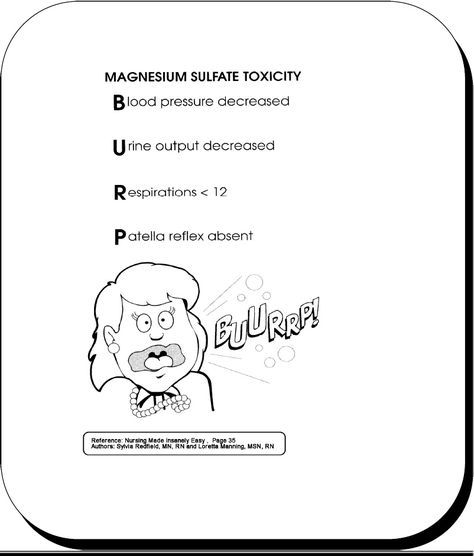A nurse on the postpartum unit is caring for four clients. For which of the following clients should the nurse notify the provider?
A client who reports luchia rubra requiring changing perineal pads every 3 hr
A client who has a urinary output of 300 mL in 8 hr
A client who is receiving magnesium sulphate and has absent deep tendon reflexes
A client who reports abdominal cramping during breastfeeding
The Correct Answer is C
A. A client who reports lochia rubra requiring changing perineal pads every 3 hr: Lochia rubra is the normal discharge during the early postpartum period. Changing perineal pads every 3 hours is within the expected range and does not warrant immediate notification of the provider.
B. A client who has a urinary output of 300 mL in 8 hr: Although the urinary output is relatively low, the information provided is not sufficient to conclude that this is abnormal. Further assessment is needed, and this finding alone may not be an emergency. However, it should be monitored.
C. A client who is receiving magnesium sulfate and has absent deep tendon reflexes: Absent deep tendon reflexes can be a sign of magnesium toxicity. Magnesium sulfate is used for various indications, such as preeclampsia or eclampsia, but it has a narrow therapeutic range. Absent deep tendon reflexes suggest the need for immediate attention and notification of the provider.

D. A client who reports abdominal cramping during breastfeeding: Abdominal cramping during breastfeeding is a common postpartum symptom associated with uterine contractions. It is a normal physiological response and does not require immediate notification of the provider.
Nursing Test Bank
Naxlex Comprehensive Predictor Exams
Related Questions
Correct Answer is B
Explanation
a: The diaphragm should be used with a spermicide, not a vaginal lubricant. Spermicide is necessary to kill sperm and increase the effectiveness of the diaphragm.
b: The diaphragm can be inserted up to 6 hours before intercourse, making it a convenient option for contraception. It should be left in place for at least 6 hours after intercourse but not more than 24 hours to ensure effectiveness.
c: The diaphragm should not be removed 2 to 4 hours after intercourse. It must remain in place for at least 6 hours after intercourse to provide effective contraception.
d:Washing the diaphragm with detergent soap can damage the latex and increase the risk of deterioration. It should be washed with mild soap and water or with a special cleanser recommended by the healthcare provider.
Correct Answer is B
Explanation
A. Postpartum hemorrhage: Effacement and dilation relate to the progress of labor, not postpartum hemorrhage. Postpartum hemorrhage is excessive bleeding that occurs after childbirth, typically within 24 hours, and can have various causes unrelated to cervical dilation.
B. Incompetent cervix: Incompetent cervix, also known as cervical insufficiency, refers to the premature and painless dilation of the cervix during the second trimester of pregnancy. It is not directly related to the dilation mentioned in the scenario. However, it is possible that the client may have misunderstood the timing of contractions, and the nurse should assess for other signs of cervical insufficiency.
C. Hyperemesis gravidarum: Hyperemesis gravidarum is severe nausea and vomiting during pregnancy, which can lead to dehydration and electrolyte imbalances. It is not directly related to cervical dilation or effacement.
D. Ectopic pregnancy: An ectopic pregnancy is a pregnancy that occurs outside the uterus, usually in the fallopian tube. Cervical dilation and effacement are not associated with ectopic pregnancies.
Whether you are a student looking to ace your exams or a practicing nurse seeking to enhance your expertise , our nursing education contents will empower you with the confidence and competence to make a difference in the lives of patients and become a respected leader in the healthcare field.
Visit Naxlex, invest in your future and unlock endless possibilities with our unparalleled nursing education contents today
Report Wrong Answer on the Current Question
Do you disagree with the answer? If yes, what is your expected answer? Explain.
Kindly be descriptive with the issue you are facing.
